If you’re healing from a breakup, guided journals like *Let That Sh*t Go* and *Soul Therapy* offer practical prompts, humor, and emotional validation to support your journey. Whether you need a playful boost, mindfulness techniques, or confidence-building exercises, these journals tailor their approach to different needs and styles. They help you process emotions, practice self-love, and move forward with clarity. Stay with me, and you’ll discover more tools to help you find peace and rebuild.
Key Takeaways
- Highlighted journals combine humor, mindfulness, and self-discovery to support emotional healing after a breakup.
- They feature manageable prompts, exercises, and reflection tools tailored for different healing stages.
- Designed for diverse audiences, including men and women, with content that promotes confidence, resilience, and peace.
- Practical features like engaging layouts, durable materials, and portable sizes encourage consistent use.
- They offer emotional validation, stress management strategies, and positive reinforcement to help move on and find peace.
The Breakup Workbook: Exercises & Advice to Help You Heal from Your Heartbreak & Create Your Best Life
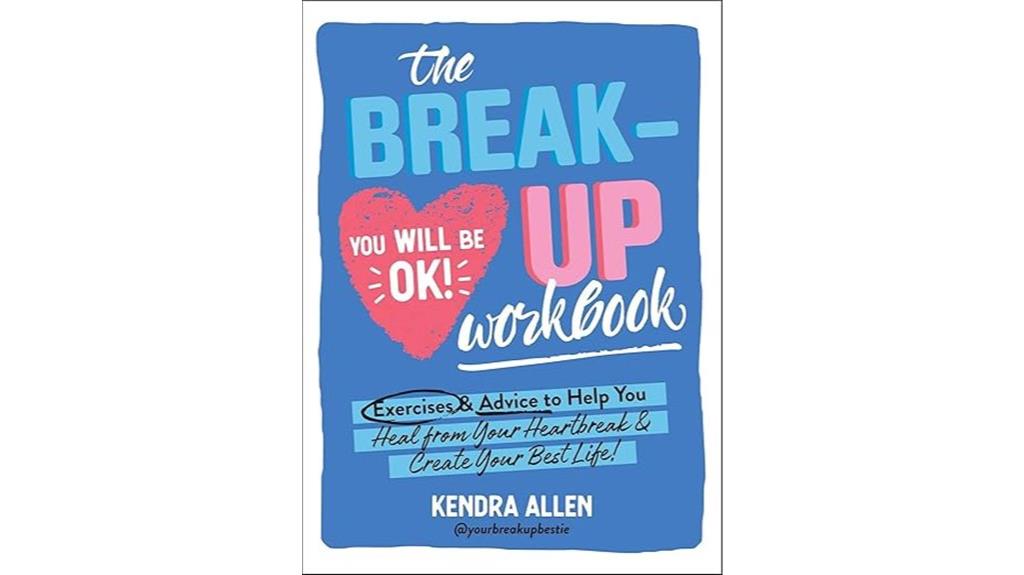
If you’re feeling overwhelmed after a breakup and need practical guidance, The Breakup Workbook is an excellent choice, especially for those just starting their healing journey. I found it incredibly helpful because it offers straightforward exercises, worksheets, and tips that make emotional recovery manageable. The baby-step approach keeps you moving forward without feeling overwhelmed, encouraging daily engagement. It validates your feelings while promoting self-care and resilience. This workbook helped me see heartbreak as an opportunity for growth, providing clear strategies to process emotions and rebuild confidence. If you’re seeking practical tools to navigate your breakup, this resource can truly support your healing.
Best For: individuals who are new to breakup recovery, seeking straightforward, manageable exercises and emotional validation to start their healing process.
Pros:
- Offers practical, easy-to-follow exercises and worksheets that facilitate emotional processing
- Promotes daily engagement with a baby-step approach to prevent feeling overwhelmed
- Validates feelings while encouraging self-care, resilience, and personal growth
Cons:
- May be less suitable for those who prefer more intensive or therapy-based approaches
- Some users might find the workbook too basic if they are further along in their recovery
- Limited guidance on dealing with complex or prolonged emotional issues beyond initial healing
Let That Sh*t Go Journal for Leaving Your Bullsh*t Behind

The “Let That Sh*t Go” journal is perfect for anyone ready to release emotional baggage and leave toxic relationships behind. It’s a candid, practical tool that combines humor, self-reflection, and straightforward prompts to help you shed negativity and stress. The lively, colorful pages encourage confronting challenges head-on with real talk and relatable advice. Designed for adults, it makes the process of letting go approachable and even fun. Whether you’re seeking mental clarity or just need a nudge to move forward, this journal helps you focus on personal growth and happiness without taking life too seriously. It’s a no-nonsense way to finally let that sh*t go.
Best For: adults looking for a humorous, straightforward way to release stress, emotional baggage, and toxic relationships while fostering personal growth and positivity.
Pros:
- Combines humor and practical prompts to make self-reflection enjoyable
- Colorful, lively design that appeals to those who appreciate vibrant visuals
- Helpful for mental health challenges like anxiety, stress, and depression
Cons:
- Adult language may not be suitable for everyone
- Some users report the binding quality deteriorates quickly
- Might not be as effective for those seeking a more structured or traditional journal
90-Day Guided Mental Health Journal for Anxiety and Wellness

Designed for those seeking daily support in managing anxiety and cultivating wellness, the Day Guided Mental Health Journal offers a structured yet flexible way to stay grounded. I use it to navigate daily stressors through prompts, reflection spaces, and weekly check-ins that track my mood and patterns. Created by a mental health advocate, it emphasizes mindfulness and self-compassion, helping me quiet my mind and build resilience. The included mantra section and guided meditation boost my confidence and calmness. Its eco-friendly design and portability make it perfect for on-the-go moments. This journal truly supports my journey toward emotional clarity, peace, and ongoing self-care.
Best For: individuals seeking daily mental health support, mindfulness practice, and emotional wellness tools to manage anxiety and foster self-care.
Pros:
- Encourages daily reflection and mindfulness to reduce stress and promote emotional clarity
- Eco-friendly design with a portable size ideal for on-the-go use and travel
- Includes additional resources like a guided meditation and mantra section to boost confidence and calmness
Cons:
- Limited to 90 days, which may require additional journaling tools for long-term use
- Plain ruling may not appeal to those preferring structured or creative page layouts
- As a physical product, it may not suit digital-only preference users
No Breakup Can Break You: The Definitive Recovery Guide for Men
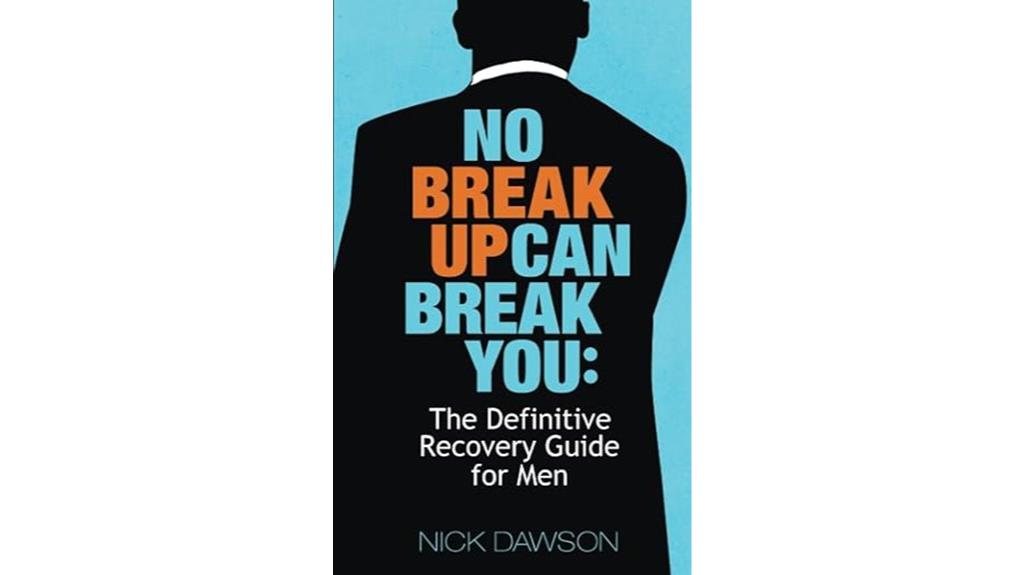
Men seeking a straightforward, practical approach to healing after a breakup will find that guided journals like Dawson’s book are especially effective. This recovery guide challenges stereotypes, showing that men feel pain and vulnerability just like anyone else. It offers science-backed strategies like exercise, socializing, and no-contact rules, making recovery manageable. Dawson’s tone is optimistic and humorous, helping you see breakup as a growth opportunity. Many readers report that the book provides clear, actionable advice that stays relevant long after the breakup. If you want a no-nonsense, supportive resource, this guide is a powerful tool to help you move on and find peace.
Best For: men seeking a practical, science-backed, and straightforward guide to recover from a breakup and move forward with confidence.
Pros:
- Offers clear, actionable strategies rooted in psychology and biology.
- Maintains an optimistic and humorous tone that encourages resilience.
- Highly relevant and easy to read, with testimonials supporting its effectiveness.
Cons:
- Some readers find the content somewhat simplistic or lacking in depth.
- Contains filler chapters on fitness or health that may be unnecessary for some.
- May not delve deeply into complex emotional or psychological issues for those seeking extensive analysis.
Soul Therapy: A 365 Day Journal for Self-Exploration
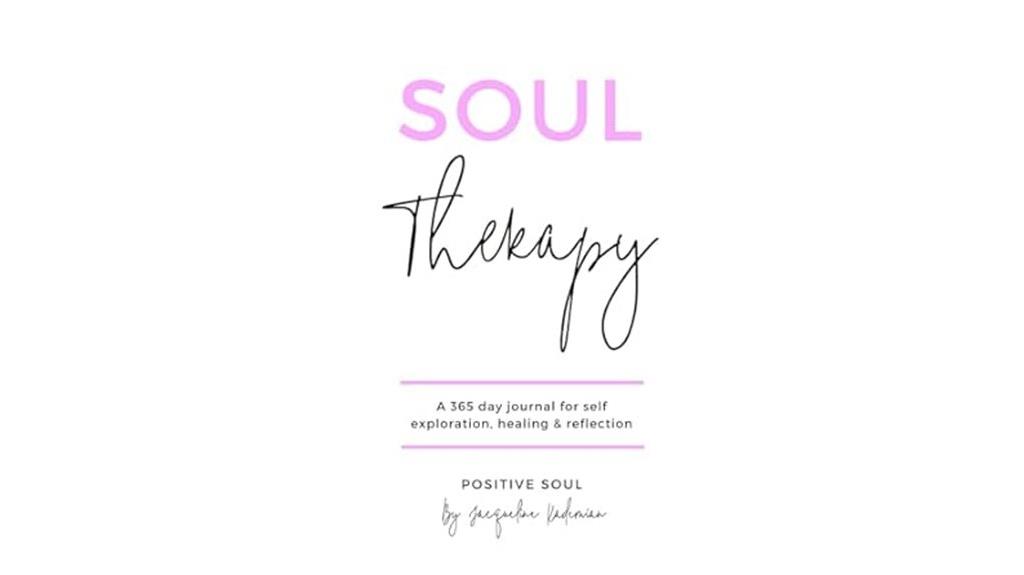
If you’re seeking a meaningful way to navigate heartbreak and rebuild self-love, Soul Therapy: A 365 Day Journal for Self-Exploration stands out as an ideal choice. This journal guides you through daily prompts that foster self-discovery, emotional growth, and gratitude. Many users find it helps establish healthier habits, boost self-esteem, and deepen introspection during tough times like breakups. Its sleek, versatile design makes it easy to incorporate into daily routines, encouraging honesty and reflection. Whether you want to process feelings or set future goals, Soul Therapy offers a structured, inspiring path toward healing and inner peace.
Best For: individuals seeking a structured, reflective tool to support emotional healing, self-discovery, and personal growth during challenging life moments like breakups or stressful routines.
Pros:
- Promotes deep introspection and emotional resilience through thoughtfully crafted prompts
- Encourages daily self-care habits, gratitude, and positive self-talk
- Versatile design allows for flexible responses, including writing, drawing, or reflection
Cons:
- Some users wish for lined pages to facilitate neater writing
- Cover durability may be limited; more robust options like leather or spiral binding could enhance longevity
- The minimal aesthetic, while versatile, may not appeal to everyone seeking a more decorative or elaborate design
Guided Self-Love and Gratitude Journal for Women

A guided self-love and gratitude journal like “Fuck It” is perfect for women who want a no-nonsense, humorous approach to boosting their mental health and self-esteem. I love how it combines witty prompts with honest reflection, making self-care feel approachable and fun. Whether you’re new to journaling or need a quick mental reset, this journal offers daily check-ins, gratitude exercises, and playful questions like “WTF moment,” helping you release stress and embrace self-love. The layout encourages spontaneous writing and lighthearted honesty, making it an ideal companion during tough times or whenever you need a boost of positivity.
Best For: women seeking a humorous, no-nonsense approach to self-love, gratitude, and mental wellness through spontaneous, light-hearted journaling.
Pros:
- Engaging prompts that combine humor and honesty to make self-care fun and accessible
- Encourages spontaneous writing and honest reflection, helping to reduce stress and boost positivity
- Suitable for beginners or those who dislike traditional journaling routines, making it easy to integrate into daily life
Cons:
- Layout and prompt placement may feel inconsistent, especially for morning versus evening journaling
- Some users find the design and printing quality to be inexpensive or less durable
- Might be more effective as a casual, quick-use journal rather than a comprehensive self-care routine
The Break Up Manual for Men: Recover From a Breakup
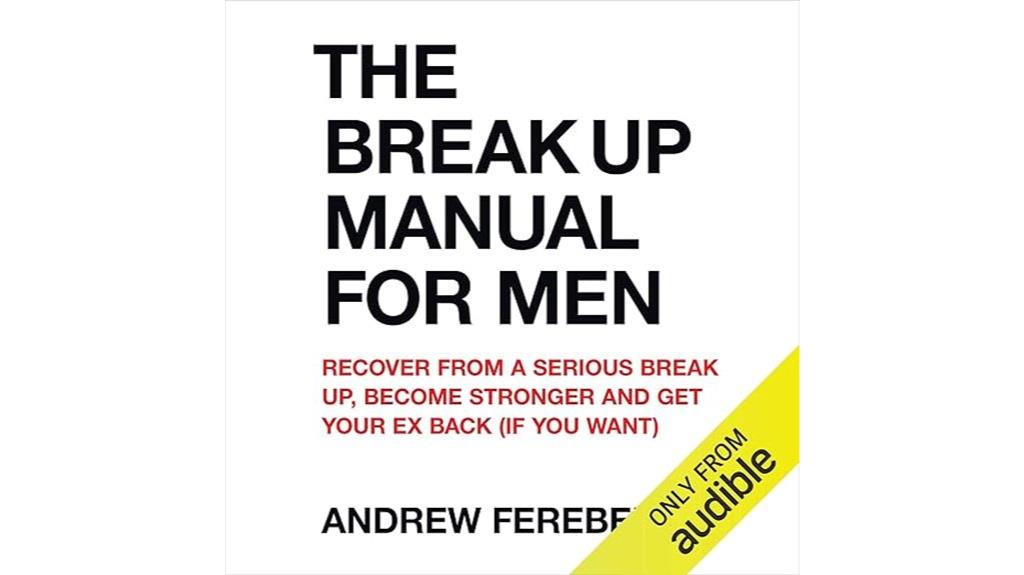
When you’re seeking focused support to process breakup emotions and rebuild your confidence, the Guided Journals for Breakup Healing stand out as an ideal choice. The Break Up Manual for Men offers practical guidance tailored to men’s emotional needs, helping you understand your reactions and thought patterns. It validates your grief and provides actionable strategies to move forward, emphasizing personal growth over reconciliation. Many men find it boosts their confidence, resilience, and motivation to improve their lives. This no-nonsense manual encourages self-awareness, acceptance, and patience, making it a valuable resource for anyone looking to recover, rebuild, and emerge stronger from a breakup.
Best For: men seeking practical, straightforward support to process breakup emotions, boost confidence, and focus on personal growth and resilience.
Pros:
- Provides clear, actionable strategies tailored specifically for men’s emotional needs
- Validates feelings of grief and encourages acceptance, normalizing the healing process
- Boosts confidence and motivation to rebuild and improve life post-breakup
Cons:
- May be considered introductory and less comprehensive for those needing in-depth therapy techniques
- Focuses primarily on mindset and self-improvement, with limited emphasis on complex emotional issues
- Some readers might find the tone too direct or no-nonsense for their personal style
Journals for Women – Self Care & Reflection Journal
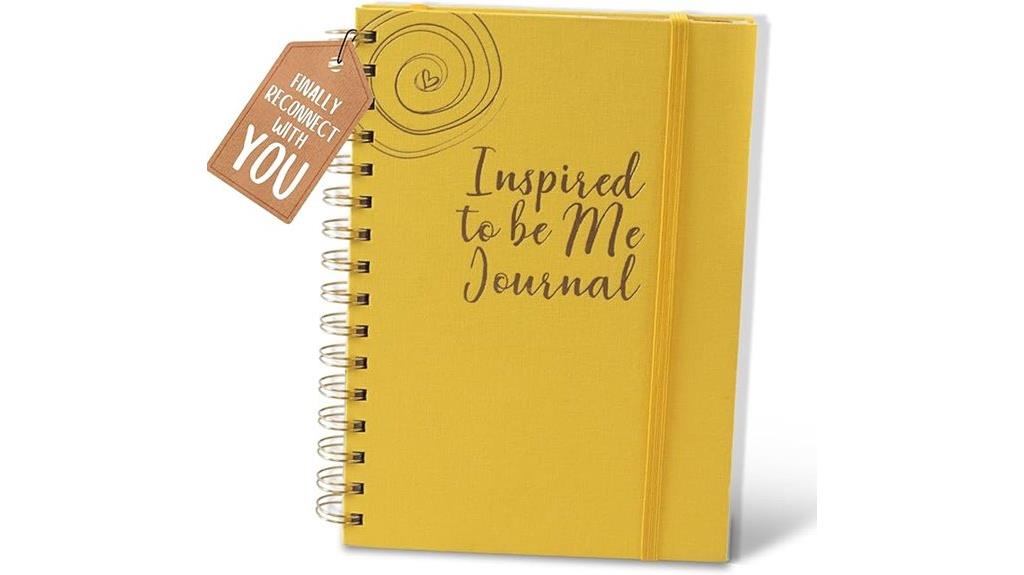
The “Inspired to Be Me” Self Care & Reflection Journal stands out as an ideal choice for women seeking emotional healing and personal growth after challenging life events, such as breakups or major shifts. This journal guides you through six months of introspection, helping reconnect with your passions, inner voice, and self-love. Its thoughtful prompts encourage gratitude, emotional regulation, and mindset shifts, creating a safe space for reflection. Crafted with high-quality materials, it’s both elegant and durable, making it a treasured keepsake. Many women find it transformative, offering gentle guidance to rebuild confidence, foster mindfulness, and find peace on their healing journey.
Best For: women seeking a heartfelt, guided tool for emotional healing, self-discovery, and personal growth during transitional or challenging life moments.
Pros:
- Thoughtfully designed prompts that promote mindfulness, gratitude, and emotional awareness
- High-quality materials with elegant, durable construction making it a meaningful keepsake
- Supports self-love, confidence, and inner peace through gentle guidance over a six-month journey
Cons:
- Limited to six months of guided reflection, which may not suit those needing longer-term journaling support
- Slightly higher price point due to premium materials and design features
- May require consistent daily or weekly commitment to fully benefit from the prompts
Factors to Consider When Choosing Guided Journals for Breakup Healing

When selecting a guided journal for breakup healing, I consider how well it aligns with my personal goals and emotional needs. I also look at the content style and tone to guarantee it feels supportive and engaging for me. Additionally, I pay attention to practical exercises, design, and usability to find a journal that truly encourages consistent reflection and growth.
Personal Relevance and Goals
How do you guarantee a guided journal truly supports your healing journey? First, it’s essential to choose one whose themes and prompts align with your personal goals—whether you’re seeking emotional validation, self-discovery, or help moving on. Think about the tone and style that resonate with you—whether it’s humorous, serious, or nurturing—to keep you engaged. Also, consider if the journal offers specific exercises tailored to your emotional needs, like managing grief or rebuilding self-esteem. Reflect on your preferred format—guided prompts, free writing, or a mix—to ensure it fits your writing style and routine. Finally, pick a journal that matches your current phase of recovery—clarity, closure, or empowerment—to stay relevant throughout your healing process.
Content Style and Tone
Choosing a guided journal that feels right for you involves paying close attention to its content style and tone. I believe these elements shape how comfortable you’ll feel opening up and processing emotions. If you prefer humor, look for a journal with a light, playful style; if you need gentle reassurance, choose one with a compassionate tone. The language—whether informal or formal—affects how relatable it feels, making it easier or harder to connect. Also, consider how prompts are structured—whether open-ended or fill-in-the-blank—matching your reflection depth and journaling habits. Ultimately, the style and tone should encourage honesty, foster emotional safety, and motivate consistent use, helping you navigate healing without feeling overwhelmed or disconnected.
Practical Exercise Variety
A guided journal with a variety of exercises keeps your healing process dynamic and engaging. I look for journals that include reflection prompts, gratitude practices, and emotional tracking, as these cover different healing aspects. Incorporating activities like visualizations, writing prompts, and mindfulness exercises helps keep things interesting and caters to different learning styles. It’s also helpful when a journal offers both structured prompts and space for spontaneous expression, so I can process feelings creatively and authentically. Balancing introspection with actionable steps ensures I explore my emotions while actively working toward recovery. Having multiple types of exercises prevents boredom and makes it more likely I’ll stick with the journal throughout my healing journey. Variety keeps the process fresh and meaningful.
Design and Usability
When selecting a guided journal for breakup healing, paying attention to its design and usability can make a significant difference in your experience. I look for a layout that’s user-friendly, with clear prompts and ample space to write, making it easier to express myself without feeling constrained. The visual appeal matters too—colors, cover material, and overall look should inspire me to pick up the journal regularly. I also consider the size and weight, ensuring it’s convenient for my lifestyle, whether I’m at home or on the go. Durability is key, so sturdy binding and quality paper give me confidence the journal will last through my healing journey. Finally, I prefer prompts organized for morning or evening reflection, aligning with my routine for consistency.
Emotional Support Level
Have you ever wondered how much emotional support a guided journal provides during breakup healing? The support level varies widely; some journals focus on validating feelings, helping you process grief without judgment. Others incorporate affirmations, mindfulness exercises, or empathy-driven prompts to boost resilience and self-compassion. The depth and frequency of support matter—more supportive journals often feature daily check-ins and space for complex emotions, making them ideal if you’re feeling overwhelmed. Choosing a journal that matches your current emotional state is key—whether you need gentle validation, encouragement, or practical coping tools. The right level of emotional support can make a significant difference in your healing process, offering comfort, understanding, and strength as you navigate through heartbreak toward peace.
Long-Term Engagement Potential
Choosing a guided journal that supports long-term engagement means considering how well it motivates you to keep returning, even during difficult days. Look for journals with varied prompts and activities that encourage daily reflection and sustain your interest over time. Features like weekly check-ins or space for ongoing thoughts can help you stay committed to your healing process. Flexible formats, such as optional dates or open-ended prompts, support personalized pacing and prevent burnout. Including elements like gratitude, self-care, and goal setting can boost your motivation and investment in healing over months or even years. Additionally, the journal’s quality, aesthetic appeal, and perceived value influence your willingness to maintain a consistent journaling habit long-term.
Frequently Asked Questions
How Do I Choose the Right Guided Journal for My Breakup Phase?
To choose the right guided journal for your breakup phase, I recommend first considering what you need most—whether it’s emotional healing, self-discovery, or closure. Look for a journal that resonates with your feelings and offers prompts that encourage honesty and reflection. I personally find that selecting one with gentle prompts and uplifting exercises helps me process emotions effectively and supports my journey toward healing and peace.
Can Guided Journals Effectively Replace Therapy During Breakup Recovery?
Can a journal truly replace therapy during breakup recovery? I don’t think so. While guided journals are fantastic tools for self-reflection and healing, they can’t substitute professional support for deep-rooted issues. Think of them as helpful companions on your journey, not the entire path. If your pain feels overwhelming, reaching out to a therapist offers personalized guidance that a journal simply can’t provide.
Are There Specific Journals Tailored for Different Types of Breakups?
Yes, there are journals tailored for different types of breakups. For example, I’ve seen ones designed specifically for heartbreak from long-term relationships, while others focus on healing from sudden or messy splits. Choosing a journal that resonates with your specific experience can make your healing process more meaningful. I recommend selecting a journal that feels personalized to your situation, as it helps you process emotions more effectively and find peace.
How Often Should I Use a Guided Journal to See Emotional Progress?
I’d say journaling is like tending a garden—you reap the most when you do it consistently. I recommend writing in your guided journal at least 3-4 times a week. This frequency helps you process emotions without feeling overwhelmed, and you’ll notice progress as you nurture your healing. Remember, it’s not about perfection but persistence—each entry is a step toward peace and clarity.
Can Guided Journals Help With Long-Term Healing and Personal Growth?
Absolutely, guided journals can support long-term healing and personal growth. I’ve found that they help me process emotions, reflect on my journey, and set new goals. Regularly using a journal keeps me mindful of my progress and encourages continuous self-improvement. They’re a valuable tool for maintaining emotional resilience, understanding myself better, and fostering growth over time. If you stay committed, you’ll likely see meaningful, lasting change.
Conclusion
If you’re serious about bouncing back and turning heartbreak into your greatest comeback, these journals are your secret weapons. They’re not just pages—they’re your personal cheerleaders, therapists, and best friends all rolled into one. Trust me, with these tools, you’ll be unstoppable, shining brighter than ever before. So go ahead—grab one, pour your heart out, and watch your pain transform into pure power. Your new, unstoppable life starts now!










